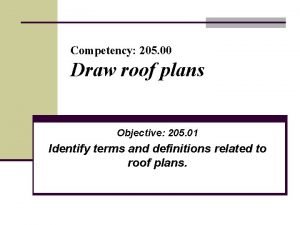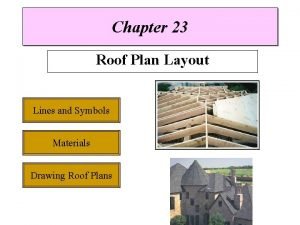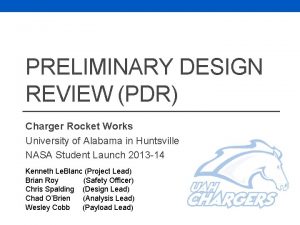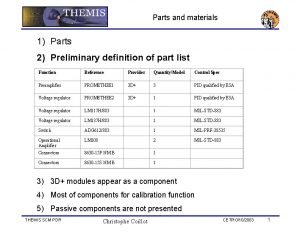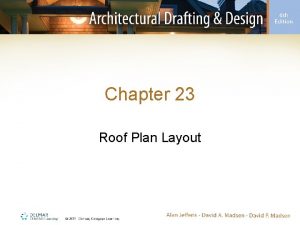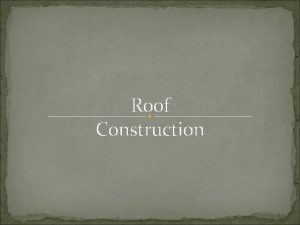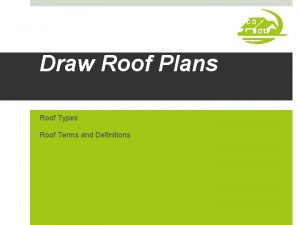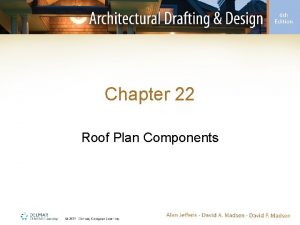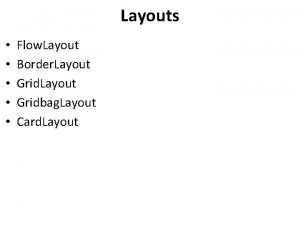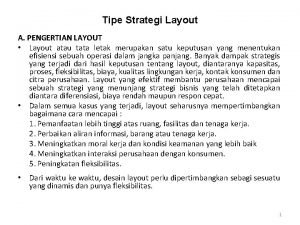Chapter 23 Roof Plan Layout Introduction Preliminary roof




















- Slides: 20

Chapter 23 Roof Plan Layout

Introduction • Preliminary roof plan – Coordinates key design elements (e. g. , floor, roof, and elevations) • Roof plan – Design is considered early in design process of a structure – Completed once design is finalized • Drafter must be familiar with lines and symbols

Representing Roof Plan Components • Steps to complete a roof plan includes: – Representing roof shape – Representing nonstructural materials – Dimensioning major components – Providing text to explain required equipment

Representing Roof Plan Components (cont’d. ) • Representing basic gable shapes – Varied ridge heights – Bay projections parallel to the ridge – Bay projections perpendicular to the ridge – Roof intersections with varied wall heights





Representing Roof Plan Components (cont’d. ) • Representing hip and Dutch hip roofs – Hip or valley passes through the corner of two intersecting walls – A hip or valley is represented using an angle equal to half the intersecting wall angle – Three lines represent intersections of hips, valleys, ridges, and overhangs • Overhang line of a Dutch hip roof intersects hip lines


Representing Structural Materials • Plan type affects the method used to show structural material

Representing Nonstructural Material • Nonstructural materials shown on roof plan: – Vents – Chimneys – Skylights – Solar panels – Diverters – Cant strips – Slope indicators – Downspouts



Dimensions • Roof plan requires few dimensions – Overhangs and openings – If trusses are used, openings must be located with modular dimensions • Providing a dimension extending from an exterior wall outer edge to the opening center is the best way to locate roof openings

Dimensions (cont’d. )

Annotation • Notes on the roof plan can be divided into: – General notes • Vent notes • Sheathing information • Roof covering and pitch – Local notes • Skylight type, size, and material • Chimney caps, cant strips, and saddles • Solar panel type and size

Drawing Gable Roof Plans • Refer to the text for complete instructions

Drawing Hip Roof Plans • Refer to the text for complete instructions

Drawing Dutch Hip Roof Plans • Refer to the text for complete instructions
 Flat roof plan example
Flat roof plan example Roof plan symbols
Roof plan symbols Preliminary business plan
Preliminary business plan Preliminary marketing plan
Preliminary marketing plan Facilities location planning
Facilities location planning Type of roof plan
Type of roof plan Truss roof steel
Truss roof steel Numerator layout
Numerator layout Smil head layout root-layout
Smil head layout root-layout Mpeg-1
Mpeg-1 Fixed layout website example
Fixed layout website example Preliminary budget
Preliminary budget Preliminary treatment adalah
Preliminary treatment adalah Preliminary survey audit
Preliminary survey audit Preliminary reference earth model
Preliminary reference earth model Preliminary design review example
Preliminary design review example Preliminary materials
Preliminary materials Mla thesis example
Mla thesis example Preliminary interview
Preliminary interview Broad problem area examples
Broad problem area examples Gayne corporation's contribution margin ratio
Gayne corporation's contribution margin ratio
